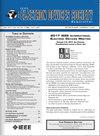氮气植入 MOSFET LDD 的电气效应
IF 2
3区 工程技术
Q3 ENGINEERING, ELECTRICAL & ELECTRONIC
引用次数: 0
摘要
这项研究的动机是解决 8 伏 N 沟道 MOSFET 的高 I_{D,off}$ 问题。我们试验了以不同剂量将氮植入 LDD。结果是,随着剂量的增加,$\rm I_{D,off}$ 增加,$\rm BV_{DSS}$ 减少。当剂量超过 1.0E15 cm $^{-2}$ 时,偏离正态分布的尾型 $\rm I_{D,off}$ 和 $\rm BV_{DSS}$ 的出现率会增加。植入的氮增强了掺杂剂在 LDD 块体中的扩散,但却抑制了其在硅表面的扩散。因此,LDD 边缘的耗尽曲率变成了负形状,并增加了电场。我们在逻辑 MOSFET 上进行了同样的实验,以全面分析其他电气效应。氮气提高了 MOSFET 的抗 HCI 能力,但当剂量超过 1.0E15 cm $^{-2}$ 时,2.5 伏和 8 伏 MOSFET 的抗 HCI 能力会下降。2.5 伏 MOSFET 的短沟道效应对氮不敏感,但当剂量超过 1.3E15 厘米 $^{-2}$ 时,CORE MOSFET 的短沟道效应受到抑制。氮通过与共植入物种和氮剂量的相互作用改变了 $\rm I_{D,sat}$。因此,氮与磷的共植入呈现出类似抛物线的 $\rm I_{D,sat}$ 趋势。然而,在植入砷的 CORE MOSFET 中,$\rm I_{D,sat}$ 并未呈现抛物线趋势,而是持续增加。本实验没有发现氮植入对 2.5 伏和 8 伏 MOSFET 有什么好处。对于所有 MOSFET,建议氮气用量不要超过 1.0E15 cm $^{-2}$ 。本文章由计算机程序翻译,如有差异,请以英文原文为准。
Electrical Effect of Nitrogen Implanted Into LDD of MOSFETs
The motivation of this study was to solve the high
$\rm I_{D,off}$
problem in 8 Volt N-channel MOSFET. We experimented with implanting nitrogen into LDD at various doses. As a result,
$\rm I_{D,off}$
increases and
$\rm BV_{DSS}$
decreases as the dose increases. When it exceeds 1.0E15 cm
$^{-2}$
, the occurrence of tail-type
$\rm I_{D,off}$
and
$\rm BV_{DSS}$
that deviate from the normal distribution increases. Implanted nitrogen enhances the diffusion of dopants in the LDD bulk but suppresses it on the silicon surface. As a result, the depletion curvature at the LDD edge becomes a negative shape and increases the electric field. We performed the same experiment on logic MOSFETs to comprehensively analyze other electrical effects. Nitrogen improves the HCI immunity of MOSFETs but degrades for 2.5 Volt and 8 Volt MOSFETs when the dose is above 1.0E15 cm
$^{-2}$
. The short-channel effect of 2.5 Volt MOSFET is insensitive to nitrogen but is suppressed in CORE MOSFET when the dose is over 1.3E15 cm
$^{-2}$
. Nitrogen changes
$\rm I_{D,sat}$
through interactions with co-implanted species and nitrogen dose. As a result, nitrogen co-implanted with phosphorus shows a parabolic-like
$\rm I_{D,sat}$
trend. However, in the case of CORE MOSFET implanted with arsenic,
$\rm I_{D,sat}$
does not show a parabolic-like trend but increases continuously. This experiment did not find much benefit from nitrogen implantation for 2.5 Volt and 8 Volt MOSFETs. For all MOSFETs, it is recommended that the nitrogen dosage not exceed 1.0E15 cm
$^{-2}$
.
求助全文
通过发布文献求助,成功后即可免费获取论文全文。
去求助
来源期刊

IEEE Journal of the Electron Devices Society
Biochemistry, Genetics and Molecular Biology-Biotechnology
CiteScore
5.20
自引率
4.30%
发文量
124
审稿时长
9 weeks
期刊介绍:
The IEEE Journal of the Electron Devices Society (J-EDS) is an open-access, fully electronic scientific journal publishing papers ranging from fundamental to applied research that are scientifically rigorous and relevant to electron devices. The J-EDS publishes original and significant contributions relating to the theory, modelling, design, performance, and reliability of electron and ion integrated circuit devices and interconnects, involving insulators, metals, organic materials, micro-plasmas, semiconductors, quantum-effect structures, vacuum devices, and emerging materials with applications in bioelectronics, biomedical electronics, computation, communications, displays, microelectromechanics, imaging, micro-actuators, nanodevices, optoelectronics, photovoltaics, power IC''s, and micro-sensors. Tutorial and review papers on these subjects are, also, published. And, occasionally special issues with a collection of papers on particular areas in more depth and breadth are, also, published. J-EDS publishes all papers that are judged to be technically valid and original.
 求助内容:
求助内容: 应助结果提醒方式:
应助结果提醒方式:


